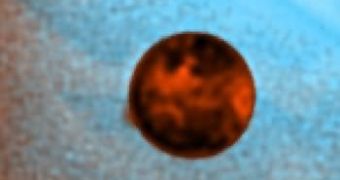Io is one of the 63 confirmed satellites of the gas giant Jupiter and the fourth largest moon in the Solar System. Although it is just 100 km larger in radius than Earth's Moon, astronomers found it to be the most active place for volcanic activity ever detected in the Universe.
With over 400 active volcanic sites on its surface, Io spews impressive amounts of volcanic gases, thus producing the largest visible gas cloud in the solar system. This extreme geologic activity is the result of tidal heating, with friction generated within Io's interior by Jupiter's varying pull on Io.
"Of the various gases that come from Io's volcanoes, sodium atoms can be detected using ground-based telescopes because the light they emit is in the visible part of the spectrum - the same familiar orange glow from sodium street lights that are in most American cities," said lead researcher Michael Mendillo, professor of electrical and computer engineering and astronomy at Boston University. "Therefore, sodium atoms become a tracer of other elements that might be more abundant, but less easy to see."
Several of Io's volcanoes produce volcanic plumes of sulfur and sodium that climb as high as 500 km (310 mi). Scientists at Boston University discovered back in 1990 an extremely large cloud of sodium (Na) atoms that spanned impressive distances to either side of Jupiter.
"If this faint structure could be seen by the naked eye, it would be over ten times the size of the full Moon, and thus the largest permanently visible object in our solar system," Mendillo explained. "Computer models suggested the types of escape processes needed to feed this giant nebula, but actual pictures of those sources eluded observers for many years."
Only this month, a new set of images showed two distinct sources of sodium atoms escaping from the satellite's surface. One of them has been discovered to be a symmetrical cloud that produces gas through collisions of the streaming ions and electrons in Jupiter's so-called plasma torus that for the first time gave astronomers a chance to observe the extent of the sputtering and stream sources.
"Since the giant sodium nebula that they create varies over periods of months to years, the source of the variability is probably not the symmetrical sputtering cloud, but the streaming-wake source that waxes and wanes with volcanic activity on Io," explained Jody Wilson, CSP senior research associate and a study co-author.
"These images provide specific spatial scales and relative strengths of these sources that now can be put into computer models that attempt to simulate how all types of gases escape from Io to populate the vast regions of space surrounding Jupiter," concluded Mendillo.

 14 DAY TRIAL //
14 DAY TRIAL //